Computerized Accounting in ERP Systems
VerifiedAdded on 2023/03/31
|17
|4085
|496
AI Summary
This report evaluates the accounting software model of SAP S/4HANA and its benefits for businesses. It discusses the features of SAP S/4HANA Finance, such as real-time data access and improved decision-making. The report also highlights challenges faced by companies in adopting SAP S/4HANA, with case studies of KARA Technologies and Aequs Software. It includes a comparison between SAP S/4HANA Finance and SAP ERP FICO.
Contribute Materials
Your contribution can guide someone’s learning journey. Share your
documents today.
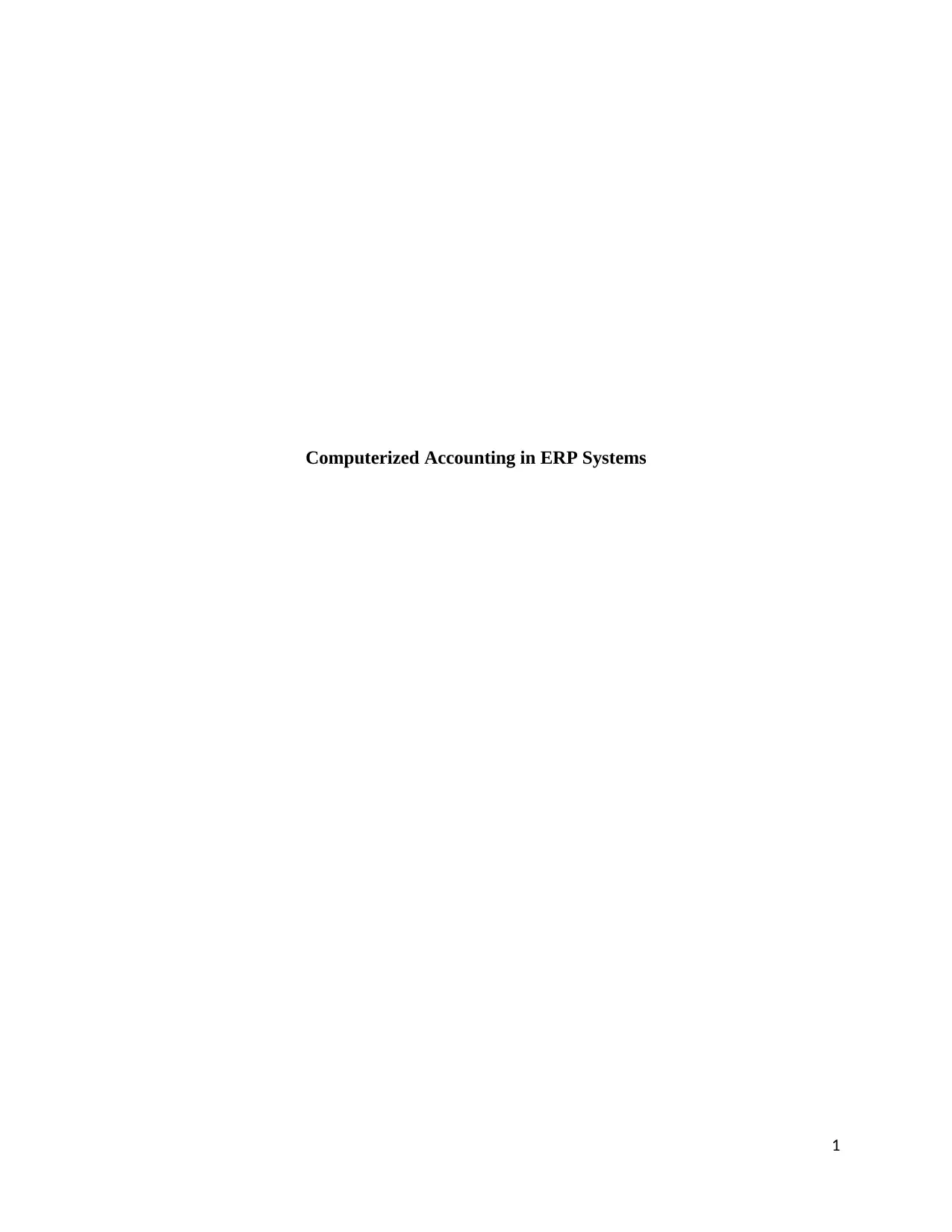
Computerized Accounting in ERP Systems
1
1
Secure Best Marks with AI Grader
Need help grading? Try our AI Grader for instant feedback on your assignments.
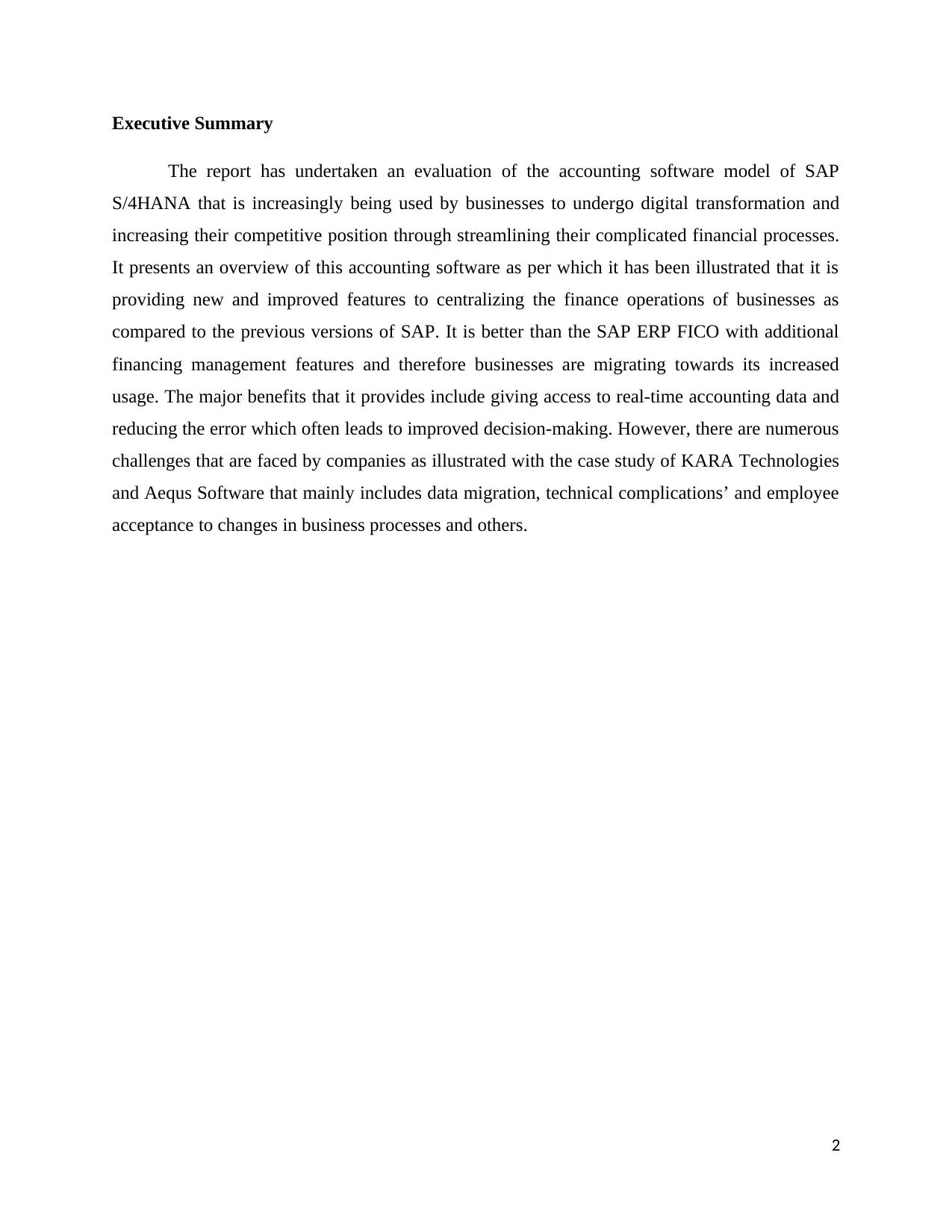
Executive Summary
The report has undertaken an evaluation of the accounting software model of SAP
S/4HANA that is increasingly being used by businesses to undergo digital transformation and
increasing their competitive position through streamlining their complicated financial processes.
It presents an overview of this accounting software as per which it has been illustrated that it is
providing new and improved features to centralizing the finance operations of businesses as
compared to the previous versions of SAP. It is better than the SAP ERP FICO with additional
financing management features and therefore businesses are migrating towards its increased
usage. The major benefits that it provides include giving access to real-time accounting data and
reducing the error which often leads to improved decision-making. However, there are numerous
challenges that are faced by companies as illustrated with the case study of KARA Technologies
and Aequs Software that mainly includes data migration, technical complications’ and employee
acceptance to changes in business processes and others.
2
The report has undertaken an evaluation of the accounting software model of SAP
S/4HANA that is increasingly being used by businesses to undergo digital transformation and
increasing their competitive position through streamlining their complicated financial processes.
It presents an overview of this accounting software as per which it has been illustrated that it is
providing new and improved features to centralizing the finance operations of businesses as
compared to the previous versions of SAP. It is better than the SAP ERP FICO with additional
financing management features and therefore businesses are migrating towards its increased
usage. The major benefits that it provides include giving access to real-time accounting data and
reducing the error which often leads to improved decision-making. However, there are numerous
challenges that are faced by companies as illustrated with the case study of KARA Technologies
and Aequs Software that mainly includes data migration, technical complications’ and employee
acceptance to changes in business processes and others.
2
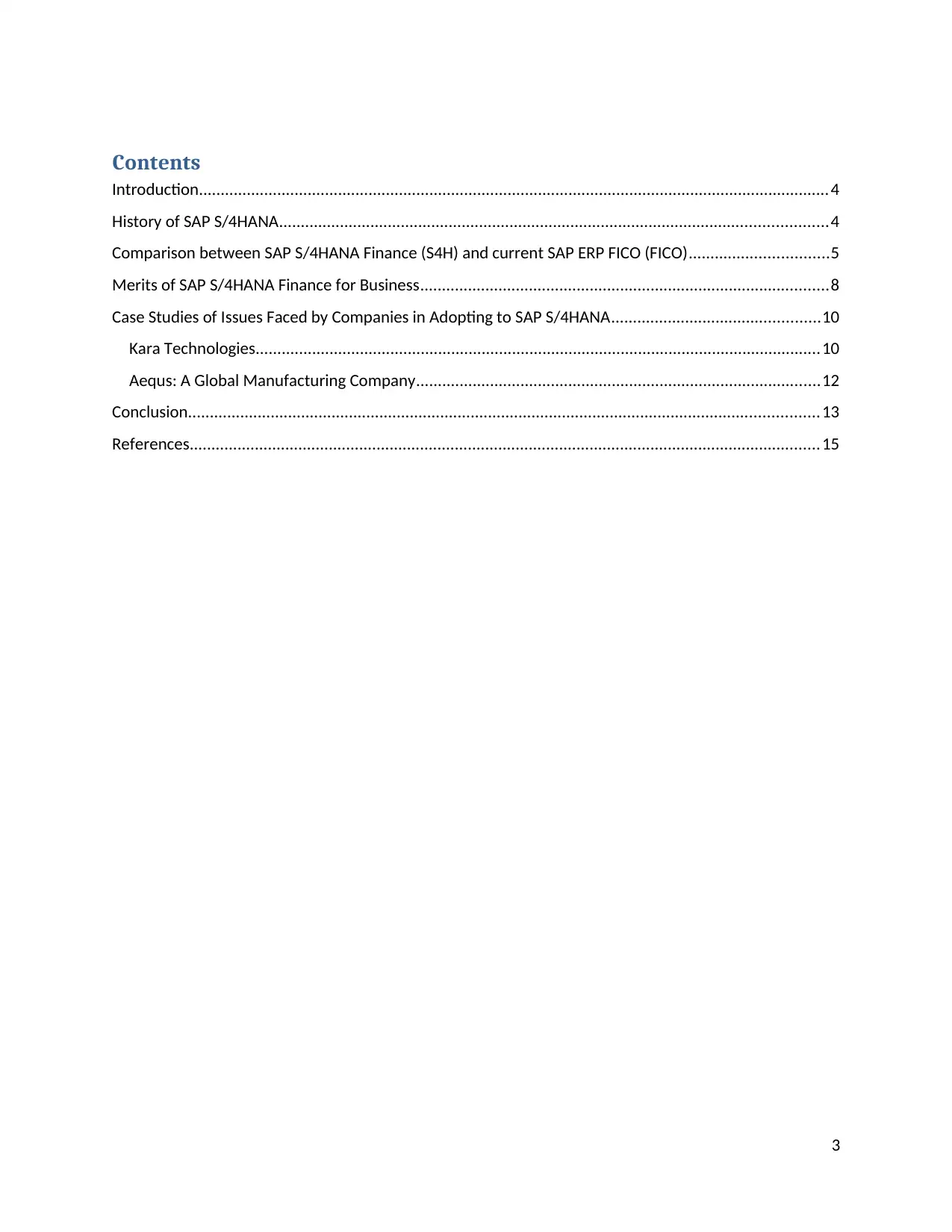
Contents
Introduction.................................................................................................................................................4
History of SAP S/4HANA..............................................................................................................................4
Comparison between SAP S/4HANA Finance (S4H) and current SAP ERP FICO (FICO)................................5
Merits of SAP S/4HANA Finance for Business..............................................................................................8
Case Studies of Issues Faced by Companies in Adopting to SAP S/4HANA................................................10
Kara Technologies..................................................................................................................................10
Aequs: A Global Manufacturing Company.............................................................................................12
Conclusion.................................................................................................................................................13
References.................................................................................................................................................15
3
Introduction.................................................................................................................................................4
History of SAP S/4HANA..............................................................................................................................4
Comparison between SAP S/4HANA Finance (S4H) and current SAP ERP FICO (FICO)................................5
Merits of SAP S/4HANA Finance for Business..............................................................................................8
Case Studies of Issues Faced by Companies in Adopting to SAP S/4HANA................................................10
Kara Technologies..................................................................................................................................10
Aequs: A Global Manufacturing Company.............................................................................................12
Conclusion.................................................................................................................................................13
References.................................................................................................................................................15
3
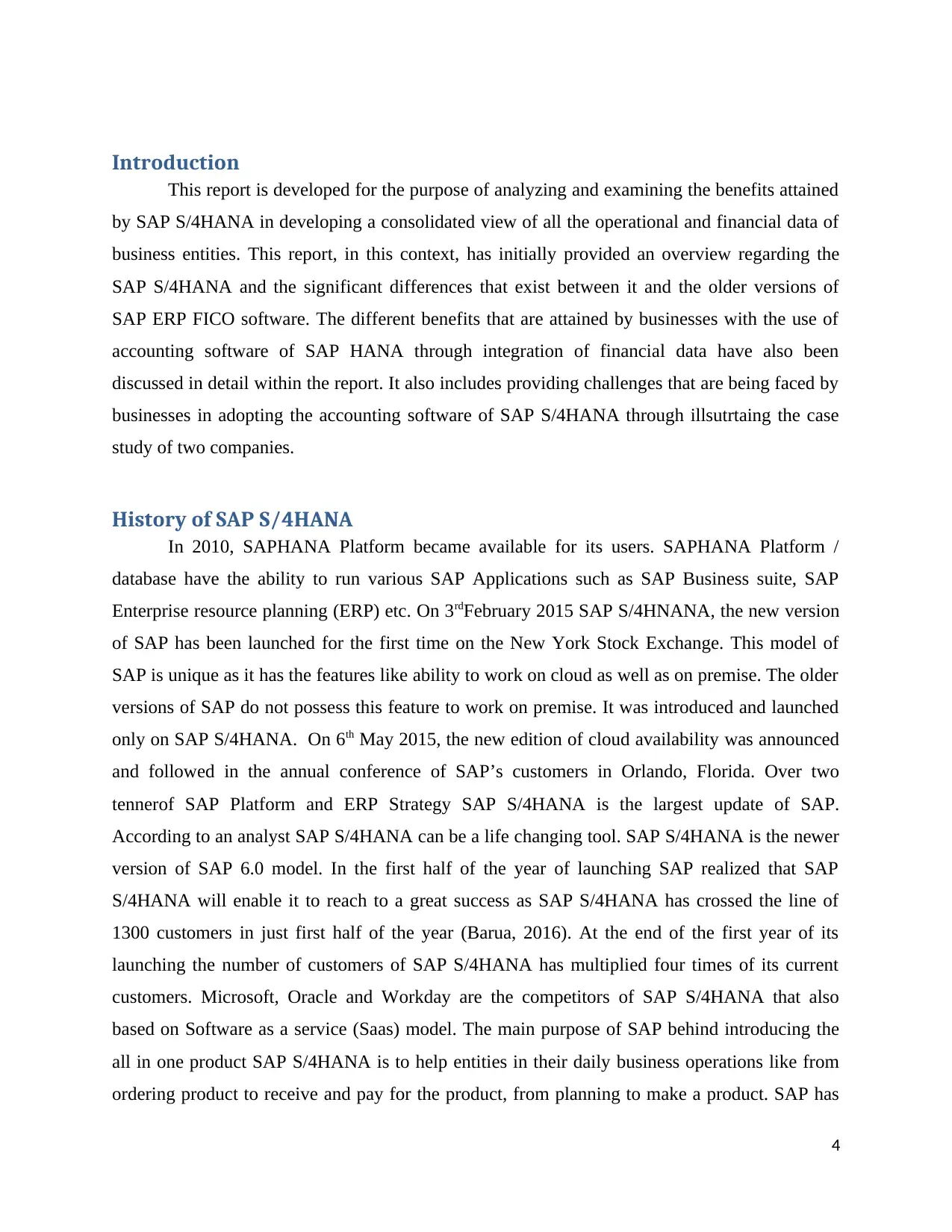
Introduction
This report is developed for the purpose of analyzing and examining the benefits attained
by SAP S/4HANA in developing a consolidated view of all the operational and financial data of
business entities. This report, in this context, has initially provided an overview regarding the
SAP S/4HANA and the significant differences that exist between it and the older versions of
SAP ERP FICO software. The different benefits that are attained by businesses with the use of
accounting software of SAP HANA through integration of financial data have also been
discussed in detail within the report. It also includes providing challenges that are being faced by
businesses in adopting the accounting software of SAP S/4HANA through illsutrtaing the case
study of two companies.
History of SAP S/4HANA
In 2010, SAPHANA Platform became available for its users. SAPHANA Platform /
database have the ability to run various SAP Applications such as SAP Business suite, SAP
Enterprise resource planning (ERP) etc. On 3rdFebruary 2015 SAP S/4HNANA, the new version
of SAP has been launched for the first time on the New York Stock Exchange. This model of
SAP is unique as it has the features like ability to work on cloud as well as on premise. The older
versions of SAP do not possess this feature to work on premise. It was introduced and launched
only on SAP S/4HANA. On 6th May 2015, the new edition of cloud availability was announced
and followed in the annual conference of SAP’s customers in Orlando, Florida. Over two
tennerof SAP Platform and ERP Strategy SAP S/4HANA is the largest update of SAP.
According to an analyst SAP S/4HANA can be a life changing tool. SAP S/4HANA is the newer
version of SAP 6.0 model. In the first half of the year of launching SAP realized that SAP
S/4HANA will enable it to reach to a great success as SAP S/4HANA has crossed the line of
1300 customers in just first half of the year (Barua, 2016). At the end of the first year of its
launching the number of customers of SAP S/4HANA has multiplied four times of its current
customers. Microsoft, Oracle and Workday are the competitors of SAP S/4HANA that also
based on Software as a service (Saas) model. The main purpose of SAP behind introducing the
all in one product SAP S/4HANA is to help entities in their daily business operations like from
ordering product to receive and pay for the product, from planning to make a product. SAP has
4
This report is developed for the purpose of analyzing and examining the benefits attained
by SAP S/4HANA in developing a consolidated view of all the operational and financial data of
business entities. This report, in this context, has initially provided an overview regarding the
SAP S/4HANA and the significant differences that exist between it and the older versions of
SAP ERP FICO software. The different benefits that are attained by businesses with the use of
accounting software of SAP HANA through integration of financial data have also been
discussed in detail within the report. It also includes providing challenges that are being faced by
businesses in adopting the accounting software of SAP S/4HANA through illsutrtaing the case
study of two companies.
History of SAP S/4HANA
In 2010, SAPHANA Platform became available for its users. SAPHANA Platform /
database have the ability to run various SAP Applications such as SAP Business suite, SAP
Enterprise resource planning (ERP) etc. On 3rdFebruary 2015 SAP S/4HNANA, the new version
of SAP has been launched for the first time on the New York Stock Exchange. This model of
SAP is unique as it has the features like ability to work on cloud as well as on premise. The older
versions of SAP do not possess this feature to work on premise. It was introduced and launched
only on SAP S/4HANA. On 6th May 2015, the new edition of cloud availability was announced
and followed in the annual conference of SAP’s customers in Orlando, Florida. Over two
tennerof SAP Platform and ERP Strategy SAP S/4HANA is the largest update of SAP.
According to an analyst SAP S/4HANA can be a life changing tool. SAP S/4HANA is the newer
version of SAP 6.0 model. In the first half of the year of launching SAP realized that SAP
S/4HANA will enable it to reach to a great success as SAP S/4HANA has crossed the line of
1300 customers in just first half of the year (Barua, 2016). At the end of the first year of its
launching the number of customers of SAP S/4HANA has multiplied four times of its current
customers. Microsoft, Oracle and Workday are the competitors of SAP S/4HANA that also
based on Software as a service (Saas) model. The main purpose of SAP behind introducing the
all in one product SAP S/4HANA is to help entities in their daily business operations like from
ordering product to receive and pay for the product, from planning to make a product. SAP has
4
Secure Best Marks with AI Grader
Need help grading? Try our AI Grader for instant feedback on your assignments.
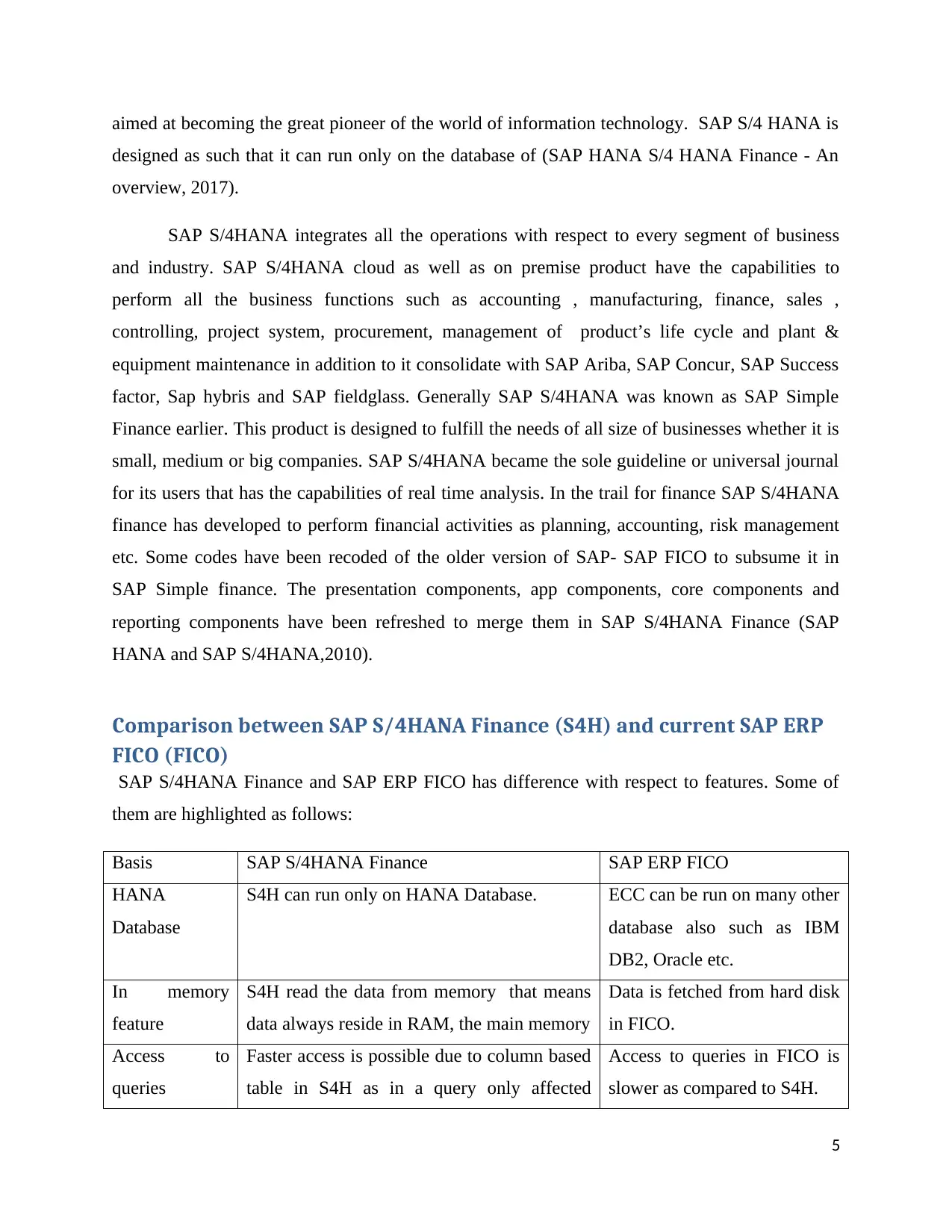
aimed at becoming the great pioneer of the world of information technology. SAP S/4 HANA is
designed as such that it can run only on the database of (SAP HANA S/4 HANA Finance - An
overview, 2017).
SAP S/4HANA integrates all the operations with respect to every segment of business
and industry. SAP S/4HANA cloud as well as on premise product have the capabilities to
perform all the business functions such as accounting , manufacturing, finance, sales ,
controlling, project system, procurement, management of product’s life cycle and plant &
equipment maintenance in addition to it consolidate with SAP Ariba, SAP Concur, SAP Success
factor, Sap hybris and SAP fieldglass. Generally SAP S/4HANA was known as SAP Simple
Finance earlier. This product is designed to fulfill the needs of all size of businesses whether it is
small, medium or big companies. SAP S/4HANA became the sole guideline or universal journal
for its users that has the capabilities of real time analysis. In the trail for finance SAP S/4HANA
finance has developed to perform financial activities as planning, accounting, risk management
etc. Some codes have been recoded of the older version of SAP- SAP FICO to subsume it in
SAP Simple finance. The presentation components, app components, core components and
reporting components have been refreshed to merge them in SAP S/4HANA Finance (SAP
HANA and SAP S/4HANA,2010).
Comparison between SAP S/4HANA Finance (S4H) and current SAP ERP
FICO (FICO)
SAP S/4HANA Finance and SAP ERP FICO has difference with respect to features. Some of
them are highlighted as follows:
Basis SAP S/4HANA Finance SAP ERP FICO
HANA
Database
S4H can run only on HANA Database. ECC can be run on many other
database also such as IBM
DB2, Oracle etc.
In memory
feature
S4H read the data from memory that means
data always reside in RAM, the main memory
Data is fetched from hard disk
in FICO.
Access to
queries
Faster access is possible due to column based
table in S4H as in a query only affected
Access to queries in FICO is
slower as compared to S4H.
5
designed as such that it can run only on the database of (SAP HANA S/4 HANA Finance - An
overview, 2017).
SAP S/4HANA integrates all the operations with respect to every segment of business
and industry. SAP S/4HANA cloud as well as on premise product have the capabilities to
perform all the business functions such as accounting , manufacturing, finance, sales ,
controlling, project system, procurement, management of product’s life cycle and plant &
equipment maintenance in addition to it consolidate with SAP Ariba, SAP Concur, SAP Success
factor, Sap hybris and SAP fieldglass. Generally SAP S/4HANA was known as SAP Simple
Finance earlier. This product is designed to fulfill the needs of all size of businesses whether it is
small, medium or big companies. SAP S/4HANA became the sole guideline or universal journal
for its users that has the capabilities of real time analysis. In the trail for finance SAP S/4HANA
finance has developed to perform financial activities as planning, accounting, risk management
etc. Some codes have been recoded of the older version of SAP- SAP FICO to subsume it in
SAP Simple finance. The presentation components, app components, core components and
reporting components have been refreshed to merge them in SAP S/4HANA Finance (SAP
HANA and SAP S/4HANA,2010).
Comparison between SAP S/4HANA Finance (S4H) and current SAP ERP
FICO (FICO)
SAP S/4HANA Finance and SAP ERP FICO has difference with respect to features. Some of
them are highlighted as follows:
Basis SAP S/4HANA Finance SAP ERP FICO
HANA
Database
S4H can run only on HANA Database. ECC can be run on many other
database also such as IBM
DB2, Oracle etc.
In memory
feature
S4H read the data from memory that means
data always reside in RAM, the main memory
Data is fetched from hard disk
in FICO.
Access to
queries
Faster access is possible due to column based
table in S4H as in a query only affected
Access to queries in FICO is
slower as compared to S4H.
5
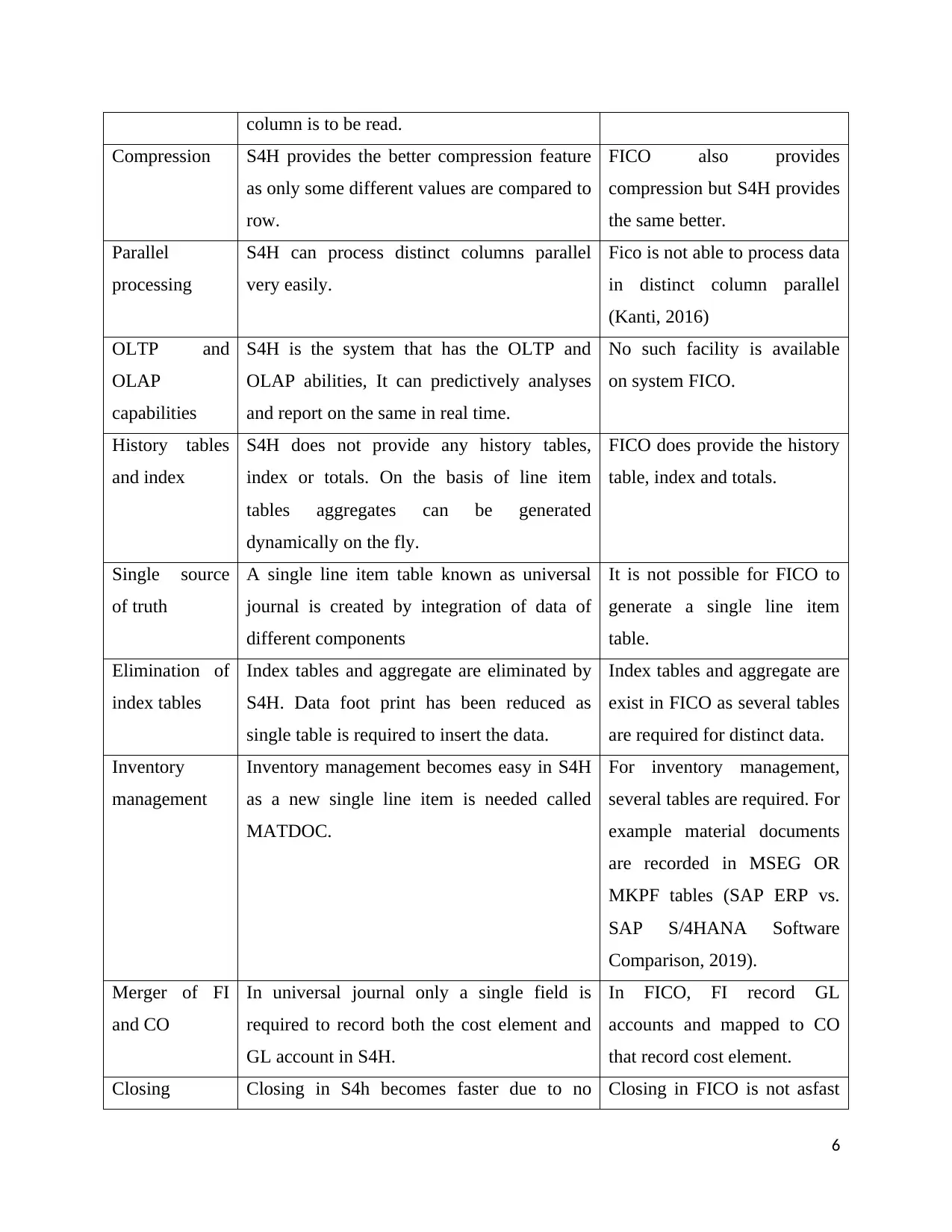
column is to be read.
Compression S4H provides the better compression feature
as only some different values are compared to
row.
FICO also provides
compression but S4H provides
the same better.
Parallel
processing
S4H can process distinct columns parallel
very easily.
Fico is not able to process data
in distinct column parallel
(Kanti, 2016)
OLTP and
OLAP
capabilities
S4H is the system that has the OLTP and
OLAP abilities, It can predictively analyses
and report on the same in real time.
No such facility is available
on system FICO.
History tables
and index
S4H does not provide any history tables,
index or totals. On the basis of line item
tables aggregates can be generated
dynamically on the fly.
FICO does provide the history
table, index and totals.
Single source
of truth
A single line item table known as universal
journal is created by integration of data of
different components
It is not possible for FICO to
generate a single line item
table.
Elimination of
index tables
Index tables and aggregate are eliminated by
S4H. Data foot print has been reduced as
single table is required to insert the data.
Index tables and aggregate are
exist in FICO as several tables
are required for distinct data.
Inventory
management
Inventory management becomes easy in S4H
as a new single line item is needed called
MATDOC.
For inventory management,
several tables are required. For
example material documents
are recorded in MSEG OR
MKPF tables (SAP ERP vs.
SAP S/4HANA Software
Comparison, 2019).
Merger of FI
and CO
In universal journal only a single field is
required to record both the cost element and
GL account in S4H.
In FICO, FI record GL
accounts and mapped to CO
that record cost element.
Closing Closing in S4h becomes faster due to no Closing in FICO is not asfast
6
Compression S4H provides the better compression feature
as only some different values are compared to
row.
FICO also provides
compression but S4H provides
the same better.
Parallel
processing
S4H can process distinct columns parallel
very easily.
Fico is not able to process data
in distinct column parallel
(Kanti, 2016)
OLTP and
OLAP
capabilities
S4H is the system that has the OLTP and
OLAP abilities, It can predictively analyses
and report on the same in real time.
No such facility is available
on system FICO.
History tables
and index
S4H does not provide any history tables,
index or totals. On the basis of line item
tables aggregates can be generated
dynamically on the fly.
FICO does provide the history
table, index and totals.
Single source
of truth
A single line item table known as universal
journal is created by integration of data of
different components
It is not possible for FICO to
generate a single line item
table.
Elimination of
index tables
Index tables and aggregate are eliminated by
S4H. Data foot print has been reduced as
single table is required to insert the data.
Index tables and aggregate are
exist in FICO as several tables
are required for distinct data.
Inventory
management
Inventory management becomes easy in S4H
as a new single line item is needed called
MATDOC.
For inventory management,
several tables are required. For
example material documents
are recorded in MSEG OR
MKPF tables (SAP ERP vs.
SAP S/4HANA Software
Comparison, 2019).
Merger of FI
and CO
In universal journal only a single field is
required to record both the cost element and
GL account in S4H.
In FICO, FI record GL
accounts and mapped to CO
that record cost element.
Closing Closing in S4h becomes faster due to no Closing in FICO is not asfast
6
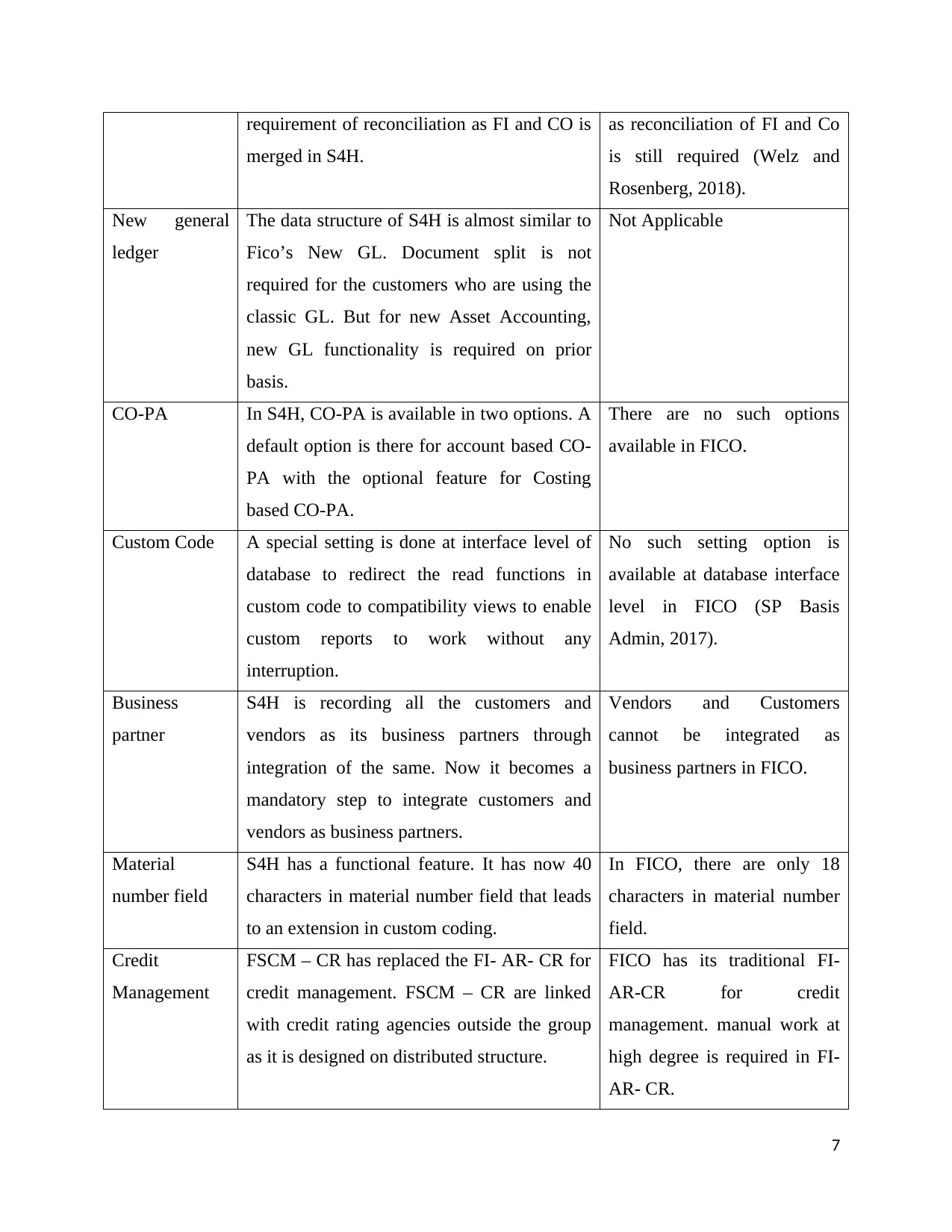
requirement of reconciliation as FI and CO is
merged in S4H.
as reconciliation of FI and Co
is still required (Welz and
Rosenberg, 2018).
New general
ledger
The data structure of S4H is almost similar to
Fico’s New GL. Document split is not
required for the customers who are using the
classic GL. But for new Asset Accounting,
new GL functionality is required on prior
basis.
Not Applicable
CO-PA In S4H, CO-PA is available in two options. A
default option is there for account based CO-
PA with the optional feature for Costing
based CO-PA.
There are no such options
available in FICO.
Custom Code A special setting is done at interface level of
database to redirect the read functions in
custom code to compatibility views to enable
custom reports to work without any
interruption.
No such setting option is
available at database interface
level in FICO (SP Basis
Admin, 2017).
Business
partner
S4H is recording all the customers and
vendors as its business partners through
integration of the same. Now it becomes a
mandatory step to integrate customers and
vendors as business partners.
Vendors and Customers
cannot be integrated as
business partners in FICO.
Material
number field
S4H has a functional feature. It has now 40
characters in material number field that leads
to an extension in custom coding.
In FICO, there are only 18
characters in material number
field.
Credit
Management
FSCM – CR has replaced the FI- AR- CR for
credit management. FSCM – CR are linked
with credit rating agencies outside the group
as it is designed on distributed structure.
FICO has its traditional FI-
AR-CR for credit
management. manual work at
high degree is required in FI-
AR- CR.
7
merged in S4H.
as reconciliation of FI and Co
is still required (Welz and
Rosenberg, 2018).
New general
ledger
The data structure of S4H is almost similar to
Fico’s New GL. Document split is not
required for the customers who are using the
classic GL. But for new Asset Accounting,
new GL functionality is required on prior
basis.
Not Applicable
CO-PA In S4H, CO-PA is available in two options. A
default option is there for account based CO-
PA with the optional feature for Costing
based CO-PA.
There are no such options
available in FICO.
Custom Code A special setting is done at interface level of
database to redirect the read functions in
custom code to compatibility views to enable
custom reports to work without any
interruption.
No such setting option is
available at database interface
level in FICO (SP Basis
Admin, 2017).
Business
partner
S4H is recording all the customers and
vendors as its business partners through
integration of the same. Now it becomes a
mandatory step to integrate customers and
vendors as business partners.
Vendors and Customers
cannot be integrated as
business partners in FICO.
Material
number field
S4H has a functional feature. It has now 40
characters in material number field that leads
to an extension in custom coding.
In FICO, there are only 18
characters in material number
field.
Credit
Management
FSCM – CR has replaced the FI- AR- CR for
credit management. FSCM – CR are linked
with credit rating agencies outside the group
as it is designed on distributed structure.
FICO has its traditional FI-
AR-CR for credit
management. manual work at
high degree is required in FI-
AR- CR.
7
Paraphrase This Document
Need a fresh take? Get an instant paraphrase of this document with our AI Paraphraser
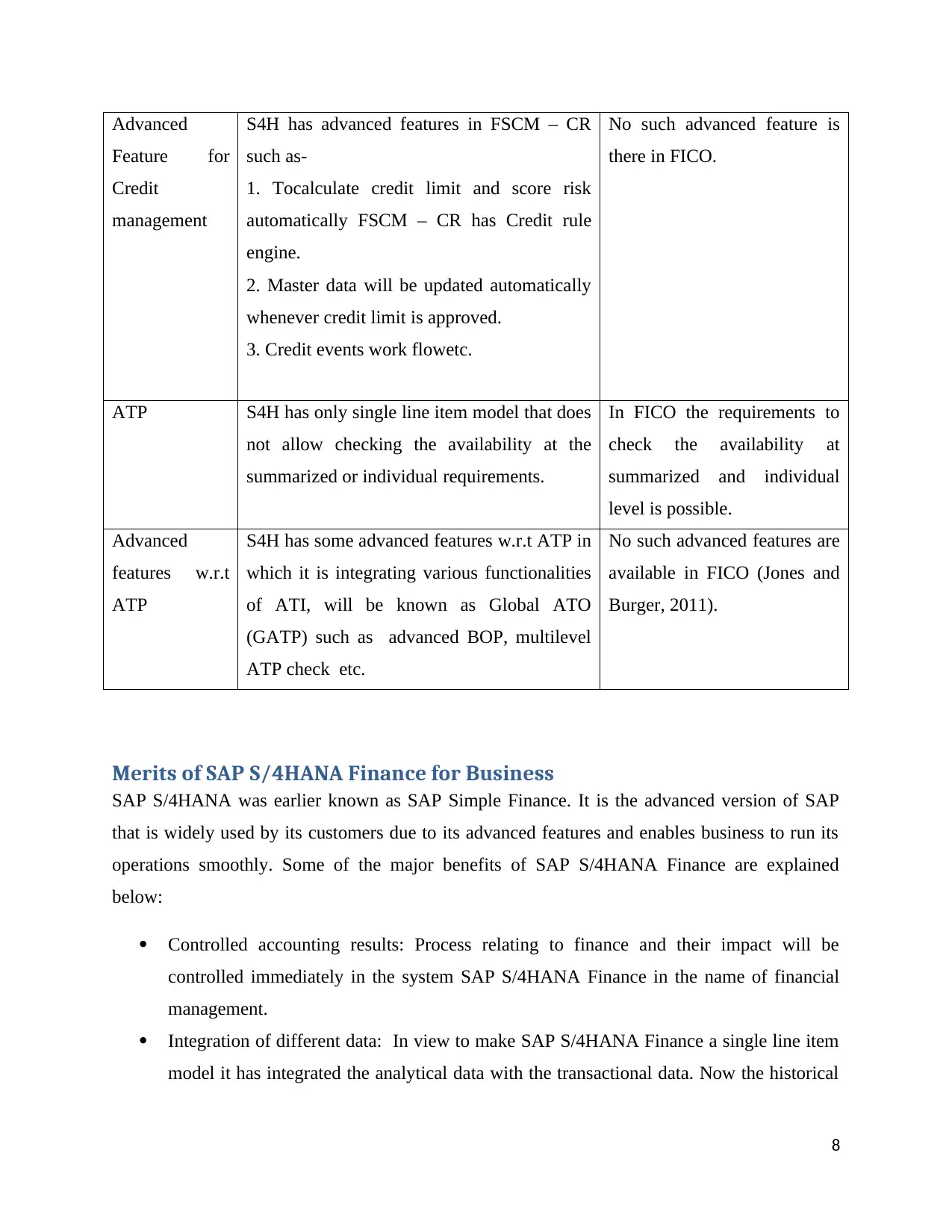
Advanced
Feature for
Credit
management
S4H has advanced features in FSCM – CR
such as-
1. Tocalculate credit limit and score risk
automatically FSCM – CR has Credit rule
engine.
2. Master data will be updated automatically
whenever credit limit is approved.
3. Credit events work flowetc.
No such advanced feature is
there in FICO.
ATP S4H has only single line item model that does
not allow checking the availability at the
summarized or individual requirements.
In FICO the requirements to
check the availability at
summarized and individual
level is possible.
Advanced
features w.r.t
ATP
S4H has some advanced features w.r.t ATP in
which it is integrating various functionalities
of ATI, will be known as Global ATO
(GATP) such as advanced BOP, multilevel
ATP check etc.
No such advanced features are
available in FICO (Jones and
Burger, 2011).
Merits of SAP S/4HANA Finance for Business
SAP S/4HANA was earlier known as SAP Simple Finance. It is the advanced version of SAP
that is widely used by its customers due to its advanced features and enables business to run its
operations smoothly. Some of the major benefits of SAP S/4HANA Finance are explained
below:
Controlled accounting results: Process relating to finance and their impact will be
controlled immediately in the system SAP S/4HANA Finance in the name of financial
management.
Integration of different data: In view to make SAP S/4HANA Finance a single line item
model it has integrated the analytical data with the transactional data. Now the historical
8
Feature for
Credit
management
S4H has advanced features in FSCM – CR
such as-
1. Tocalculate credit limit and score risk
automatically FSCM – CR has Credit rule
engine.
2. Master data will be updated automatically
whenever credit limit is approved.
3. Credit events work flowetc.
No such advanced feature is
there in FICO.
ATP S4H has only single line item model that does
not allow checking the availability at the
summarized or individual requirements.
In FICO the requirements to
check the availability at
summarized and individual
level is possible.
Advanced
features w.r.t
ATP
S4H has some advanced features w.r.t ATP in
which it is integrating various functionalities
of ATI, will be known as Global ATO
(GATP) such as advanced BOP, multilevel
ATP check etc.
No such advanced features are
available in FICO (Jones and
Burger, 2011).
Merits of SAP S/4HANA Finance for Business
SAP S/4HANA was earlier known as SAP Simple Finance. It is the advanced version of SAP
that is widely used by its customers due to its advanced features and enables business to run its
operations smoothly. Some of the major benefits of SAP S/4HANA Finance are explained
below:
Controlled accounting results: Process relating to finance and their impact will be
controlled immediately in the system SAP S/4HANA Finance in the name of financial
management.
Integration of different data: In view to make SAP S/4HANA Finance a single line item
model it has integrated the analytical data with the transactional data. Now the historical
8
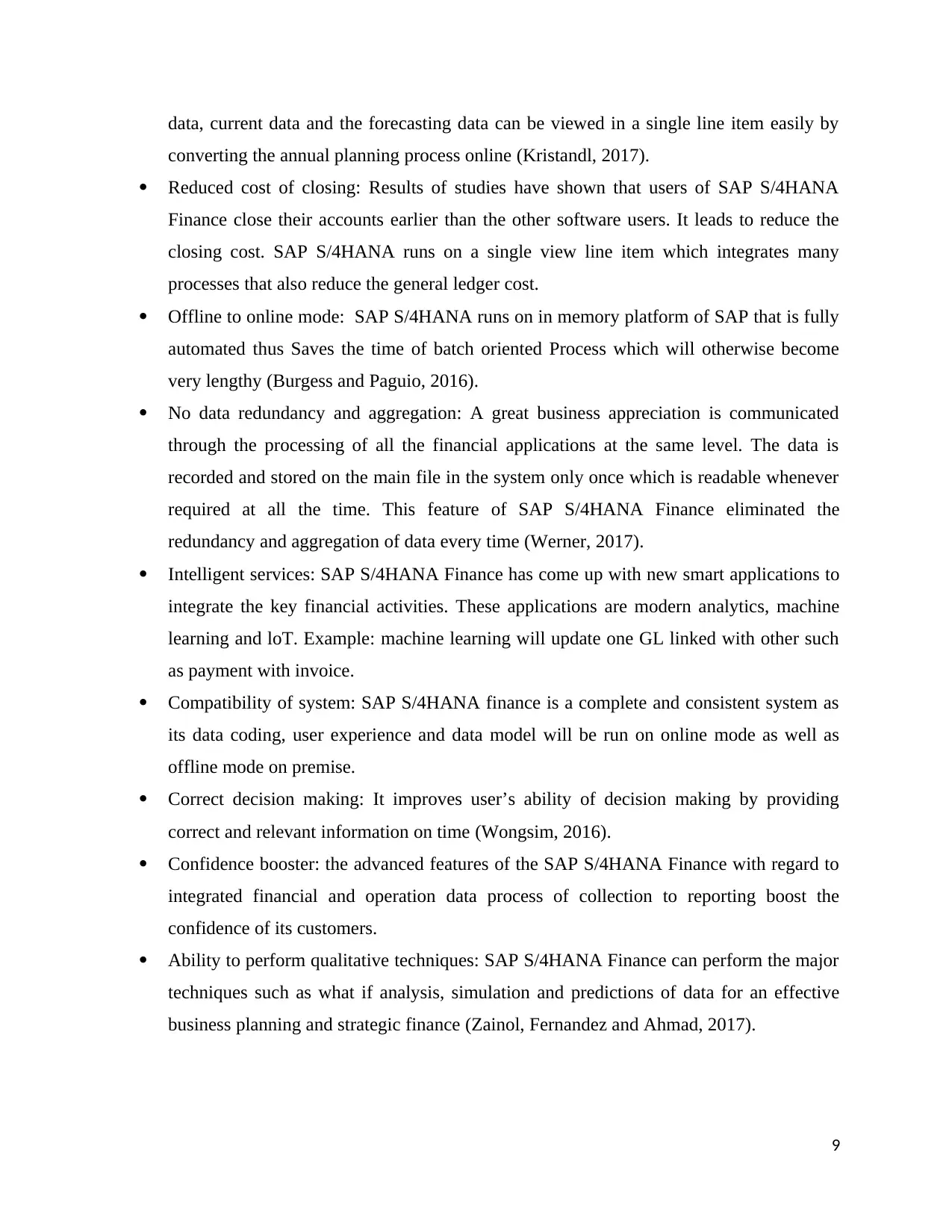
data, current data and the forecasting data can be viewed in a single line item easily by
converting the annual planning process online (Kristandl, 2017).
Reduced cost of closing: Results of studies have shown that users of SAP S/4HANA
Finance close their accounts earlier than the other software users. It leads to reduce the
closing cost. SAP S/4HANA runs on a single view line item which integrates many
processes that also reduce the general ledger cost.
Offline to online mode: SAP S/4HANA runs on in memory platform of SAP that is fully
automated thus Saves the time of batch oriented Process which will otherwise become
very lengthy (Burgess and Paguio, 2016).
No data redundancy and aggregation: A great business appreciation is communicated
through the processing of all the financial applications at the same level. The data is
recorded and stored on the main file in the system only once which is readable whenever
required at all the time. This feature of SAP S/4HANA Finance eliminated the
redundancy and aggregation of data every time (Werner, 2017).
Intelligent services: SAP S/4HANA Finance has come up with new smart applications to
integrate the key financial activities. These applications are modern analytics, machine
learning and loT. Example: machine learning will update one GL linked with other such
as payment with invoice.
Compatibility of system: SAP S/4HANA finance is a complete and consistent system as
its data coding, user experience and data model will be run on online mode as well as
offline mode on premise.
Correct decision making: It improves user’s ability of decision making by providing
correct and relevant information on time (Wongsim, 2016).
Confidence booster: the advanced features of the SAP S/4HANA Finance with regard to
integrated financial and operation data process of collection to reporting boost the
confidence of its customers.
Ability to perform qualitative techniques: SAP S/4HANA Finance can perform the major
techniques such as what if analysis, simulation and predictions of data for an effective
business planning and strategic finance (Zainol, Fernandez and Ahmad, 2017).
9
converting the annual planning process online (Kristandl, 2017).
Reduced cost of closing: Results of studies have shown that users of SAP S/4HANA
Finance close their accounts earlier than the other software users. It leads to reduce the
closing cost. SAP S/4HANA runs on a single view line item which integrates many
processes that also reduce the general ledger cost.
Offline to online mode: SAP S/4HANA runs on in memory platform of SAP that is fully
automated thus Saves the time of batch oriented Process which will otherwise become
very lengthy (Burgess and Paguio, 2016).
No data redundancy and aggregation: A great business appreciation is communicated
through the processing of all the financial applications at the same level. The data is
recorded and stored on the main file in the system only once which is readable whenever
required at all the time. This feature of SAP S/4HANA Finance eliminated the
redundancy and aggregation of data every time (Werner, 2017).
Intelligent services: SAP S/4HANA Finance has come up with new smart applications to
integrate the key financial activities. These applications are modern analytics, machine
learning and loT. Example: machine learning will update one GL linked with other such
as payment with invoice.
Compatibility of system: SAP S/4HANA finance is a complete and consistent system as
its data coding, user experience and data model will be run on online mode as well as
offline mode on premise.
Correct decision making: It improves user’s ability of decision making by providing
correct and relevant information on time (Wongsim, 2016).
Confidence booster: the advanced features of the SAP S/4HANA Finance with regard to
integrated financial and operation data process of collection to reporting boost the
confidence of its customers.
Ability to perform qualitative techniques: SAP S/4HANA Finance can perform the major
techniques such as what if analysis, simulation and predictions of data for an effective
business planning and strategic finance (Zainol, Fernandez and Ahmad, 2017).
9
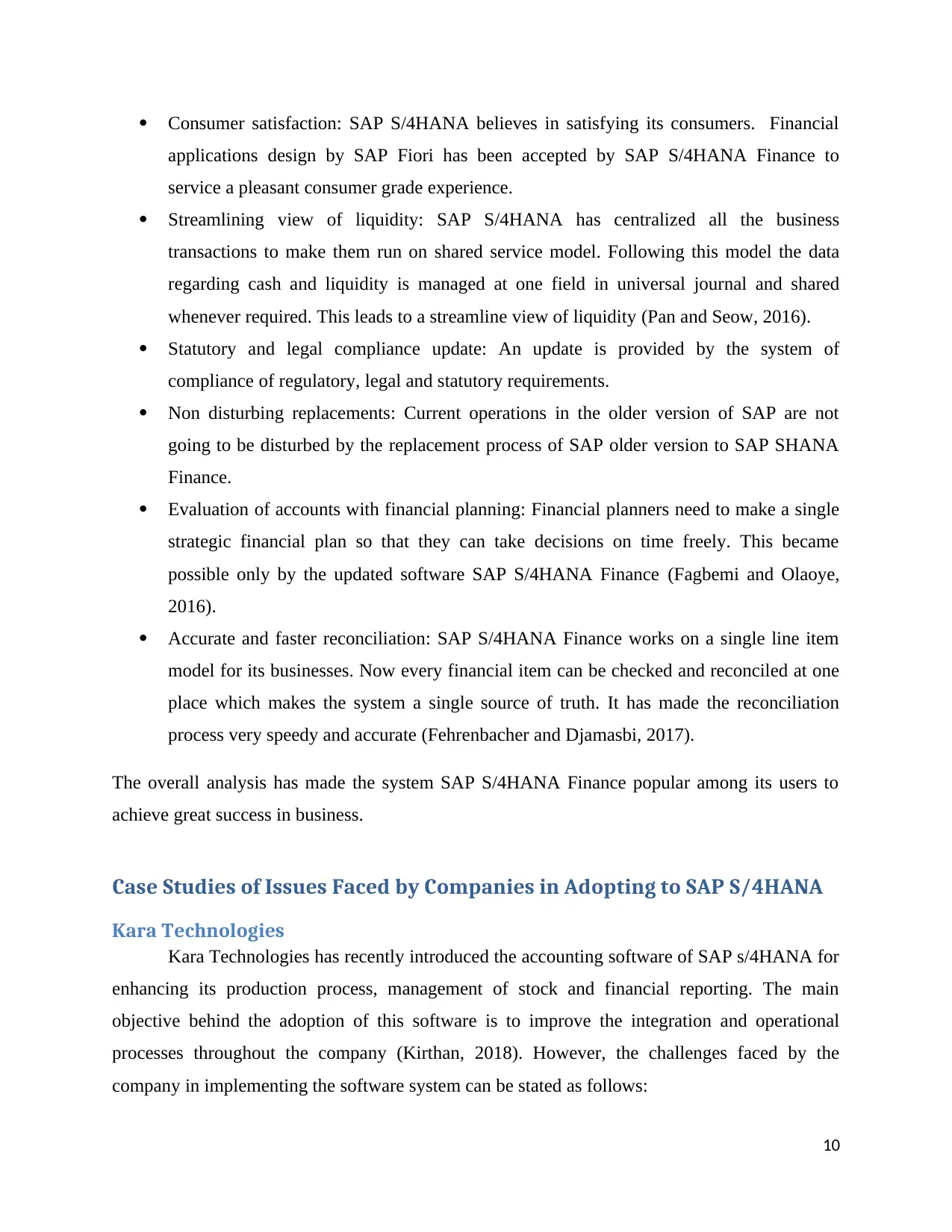
Consumer satisfaction: SAP S/4HANA believes in satisfying its consumers. Financial
applications design by SAP Fiori has been accepted by SAP S/4HANA Finance to
service a pleasant consumer grade experience.
Streamlining view of liquidity: SAP S/4HANA has centralized all the business
transactions to make them run on shared service model. Following this model the data
regarding cash and liquidity is managed at one field in universal journal and shared
whenever required. This leads to a streamline view of liquidity (Pan and Seow, 2016).
Statutory and legal compliance update: An update is provided by the system of
compliance of regulatory, legal and statutory requirements.
Non disturbing replacements: Current operations in the older version of SAP are not
going to be disturbed by the replacement process of SAP older version to SAP SHANA
Finance.
Evaluation of accounts with financial planning: Financial planners need to make a single
strategic financial plan so that they can take decisions on time freely. This became
possible only by the updated software SAP S/4HANA Finance (Fagbemi and Olaoye,
2016).
Accurate and faster reconciliation: SAP S/4HANA Finance works on a single line item
model for its businesses. Now every financial item can be checked and reconciled at one
place which makes the system a single source of truth. It has made the reconciliation
process very speedy and accurate (Fehrenbacher and Djamasbi, 2017).
The overall analysis has made the system SAP S/4HANA Finance popular among its users to
achieve great success in business.
Case Studies of Issues Faced by Companies in Adopting to SAP S/4HANA
Kara Technologies
Kara Technologies has recently introduced the accounting software of SAP s/4HANA for
enhancing its production process, management of stock and financial reporting. The main
objective behind the adoption of this software is to improve the integration and operational
processes throughout the company (Kirthan, 2018). However, the challenges faced by the
company in implementing the software system can be stated as follows:
10
applications design by SAP Fiori has been accepted by SAP S/4HANA Finance to
service a pleasant consumer grade experience.
Streamlining view of liquidity: SAP S/4HANA has centralized all the business
transactions to make them run on shared service model. Following this model the data
regarding cash and liquidity is managed at one field in universal journal and shared
whenever required. This leads to a streamline view of liquidity (Pan and Seow, 2016).
Statutory and legal compliance update: An update is provided by the system of
compliance of regulatory, legal and statutory requirements.
Non disturbing replacements: Current operations in the older version of SAP are not
going to be disturbed by the replacement process of SAP older version to SAP SHANA
Finance.
Evaluation of accounts with financial planning: Financial planners need to make a single
strategic financial plan so that they can take decisions on time freely. This became
possible only by the updated software SAP S/4HANA Finance (Fagbemi and Olaoye,
2016).
Accurate and faster reconciliation: SAP S/4HANA Finance works on a single line item
model for its businesses. Now every financial item can be checked and reconciled at one
place which makes the system a single source of truth. It has made the reconciliation
process very speedy and accurate (Fehrenbacher and Djamasbi, 2017).
The overall analysis has made the system SAP S/4HANA Finance popular among its users to
achieve great success in business.
Case Studies of Issues Faced by Companies in Adopting to SAP S/4HANA
Kara Technologies
Kara Technologies has recently introduced the accounting software of SAP s/4HANA for
enhancing its production process, management of stock and financial reporting. The main
objective behind the adoption of this software is to improve the integration and operational
processes throughout the company (Kirthan, 2018). However, the challenges faced by the
company in implementing the software system can be stated as follows:
10
Secure Best Marks with AI Grader
Need help grading? Try our AI Grader for instant feedback on your assignments.
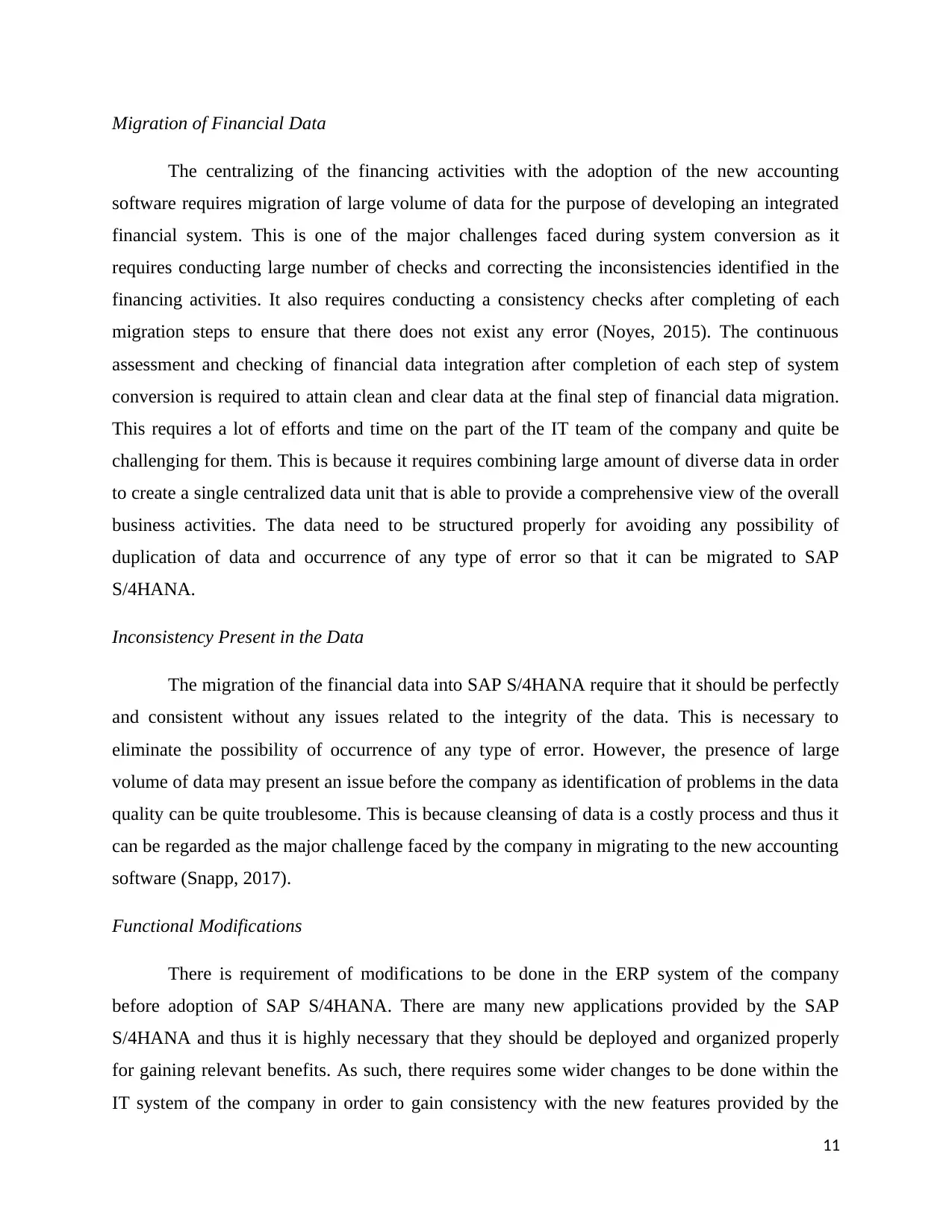
Migration of Financial Data
The centralizing of the financing activities with the adoption of the new accounting
software requires migration of large volume of data for the purpose of developing an integrated
financial system. This is one of the major challenges faced during system conversion as it
requires conducting large number of checks and correcting the inconsistencies identified in the
financing activities. It also requires conducting a consistency checks after completing of each
migration steps to ensure that there does not exist any error (Noyes, 2015). The continuous
assessment and checking of financial data integration after completion of each step of system
conversion is required to attain clean and clear data at the final step of financial data migration.
This requires a lot of efforts and time on the part of the IT team of the company and quite be
challenging for them. This is because it requires combining large amount of diverse data in order
to create a single centralized data unit that is able to provide a comprehensive view of the overall
business activities. The data need to be structured properly for avoiding any possibility of
duplication of data and occurrence of any type of error so that it can be migrated to SAP
S/4HANA.
Inconsistency Present in the Data
The migration of the financial data into SAP S/4HANA require that it should be perfectly
and consistent without any issues related to the integrity of the data. This is necessary to
eliminate the possibility of occurrence of any type of error. However, the presence of large
volume of data may present an issue before the company as identification of problems in the data
quality can be quite troublesome. This is because cleansing of data is a costly process and thus it
can be regarded as the major challenge faced by the company in migrating to the new accounting
software (Snapp, 2017).
Functional Modifications
There is requirement of modifications to be done in the ERP system of the company
before adoption of SAP S/4HANA. There are many new applications provided by the SAP
S/4HANA and thus it is highly necessary that they should be deployed and organized properly
for gaining relevant benefits. As such, there requires some wider changes to be done within the
IT system of the company in order to gain consistency with the new features provided by the
11
The centralizing of the financing activities with the adoption of the new accounting
software requires migration of large volume of data for the purpose of developing an integrated
financial system. This is one of the major challenges faced during system conversion as it
requires conducting large number of checks and correcting the inconsistencies identified in the
financing activities. It also requires conducting a consistency checks after completing of each
migration steps to ensure that there does not exist any error (Noyes, 2015). The continuous
assessment and checking of financial data integration after completion of each step of system
conversion is required to attain clean and clear data at the final step of financial data migration.
This requires a lot of efforts and time on the part of the IT team of the company and quite be
challenging for them. This is because it requires combining large amount of diverse data in order
to create a single centralized data unit that is able to provide a comprehensive view of the overall
business activities. The data need to be structured properly for avoiding any possibility of
duplication of data and occurrence of any type of error so that it can be migrated to SAP
S/4HANA.
Inconsistency Present in the Data
The migration of the financial data into SAP S/4HANA require that it should be perfectly
and consistent without any issues related to the integrity of the data. This is necessary to
eliminate the possibility of occurrence of any type of error. However, the presence of large
volume of data may present an issue before the company as identification of problems in the data
quality can be quite troublesome. This is because cleansing of data is a costly process and thus it
can be regarded as the major challenge faced by the company in migrating to the new accounting
software (Snapp, 2017).
Functional Modifications
There is requirement of modifications to be done in the ERP system of the company
before adoption of SAP S/4HANA. There are many new applications provided by the SAP
S/4HANA and thus it is highly necessary that they should be deployed and organized properly
for gaining relevant benefits. As such, there requires some wider changes to be done within the
IT system of the company in order to gain consistency with the new features provided by the
11
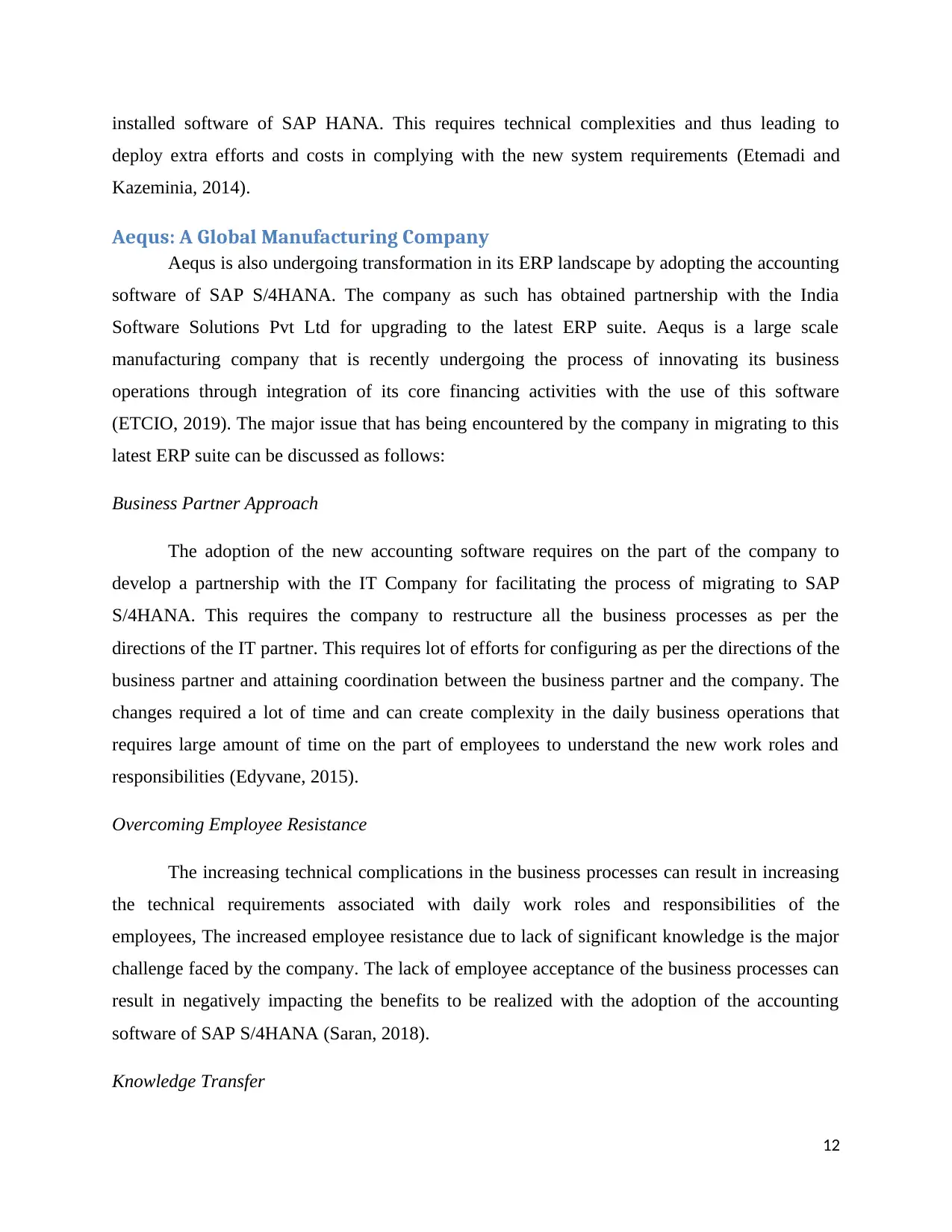
installed software of SAP HANA. This requires technical complexities and thus leading to
deploy extra efforts and costs in complying with the new system requirements (Etemadi and
Kazeminia, 2014).
Aequs: A Global Manufacturing Company
Aequs is also undergoing transformation in its ERP landscape by adopting the accounting
software of SAP S/4HANA. The company as such has obtained partnership with the India
Software Solutions Pvt Ltd for upgrading to the latest ERP suite. Aequs is a large scale
manufacturing company that is recently undergoing the process of innovating its business
operations through integration of its core financing activities with the use of this software
(ETCIO, 2019). The major issue that has being encountered by the company in migrating to this
latest ERP suite can be discussed as follows:
Business Partner Approach
The adoption of the new accounting software requires on the part of the company to
develop a partnership with the IT Company for facilitating the process of migrating to SAP
S/4HANA. This requires the company to restructure all the business processes as per the
directions of the IT partner. This requires lot of efforts for configuring as per the directions of the
business partner and attaining coordination between the business partner and the company. The
changes required a lot of time and can create complexity in the daily business operations that
requires large amount of time on the part of employees to understand the new work roles and
responsibilities (Edyvane, 2015).
Overcoming Employee Resistance
The increasing technical complications in the business processes can result in increasing
the technical requirements associated with daily work roles and responsibilities of the
employees, The increased employee resistance due to lack of significant knowledge is the major
challenge faced by the company. The lack of employee acceptance of the business processes can
result in negatively impacting the benefits to be realized with the adoption of the accounting
software of SAP S/4HANA (Saran, 2018).
Knowledge Transfer
12
deploy extra efforts and costs in complying with the new system requirements (Etemadi and
Kazeminia, 2014).
Aequs: A Global Manufacturing Company
Aequs is also undergoing transformation in its ERP landscape by adopting the accounting
software of SAP S/4HANA. The company as such has obtained partnership with the India
Software Solutions Pvt Ltd for upgrading to the latest ERP suite. Aequs is a large scale
manufacturing company that is recently undergoing the process of innovating its business
operations through integration of its core financing activities with the use of this software
(ETCIO, 2019). The major issue that has being encountered by the company in migrating to this
latest ERP suite can be discussed as follows:
Business Partner Approach
The adoption of the new accounting software requires on the part of the company to
develop a partnership with the IT Company for facilitating the process of migrating to SAP
S/4HANA. This requires the company to restructure all the business processes as per the
directions of the IT partner. This requires lot of efforts for configuring as per the directions of the
business partner and attaining coordination between the business partner and the company. The
changes required a lot of time and can create complexity in the daily business operations that
requires large amount of time on the part of employees to understand the new work roles and
responsibilities (Edyvane, 2015).
Overcoming Employee Resistance
The increasing technical complications in the business processes can result in increasing
the technical requirements associated with daily work roles and responsibilities of the
employees, The increased employee resistance due to lack of significant knowledge is the major
challenge faced by the company. The lack of employee acceptance of the business processes can
result in negatively impacting the benefits to be realized with the adoption of the accounting
software of SAP S/4HANA (Saran, 2018).
Knowledge Transfer
12
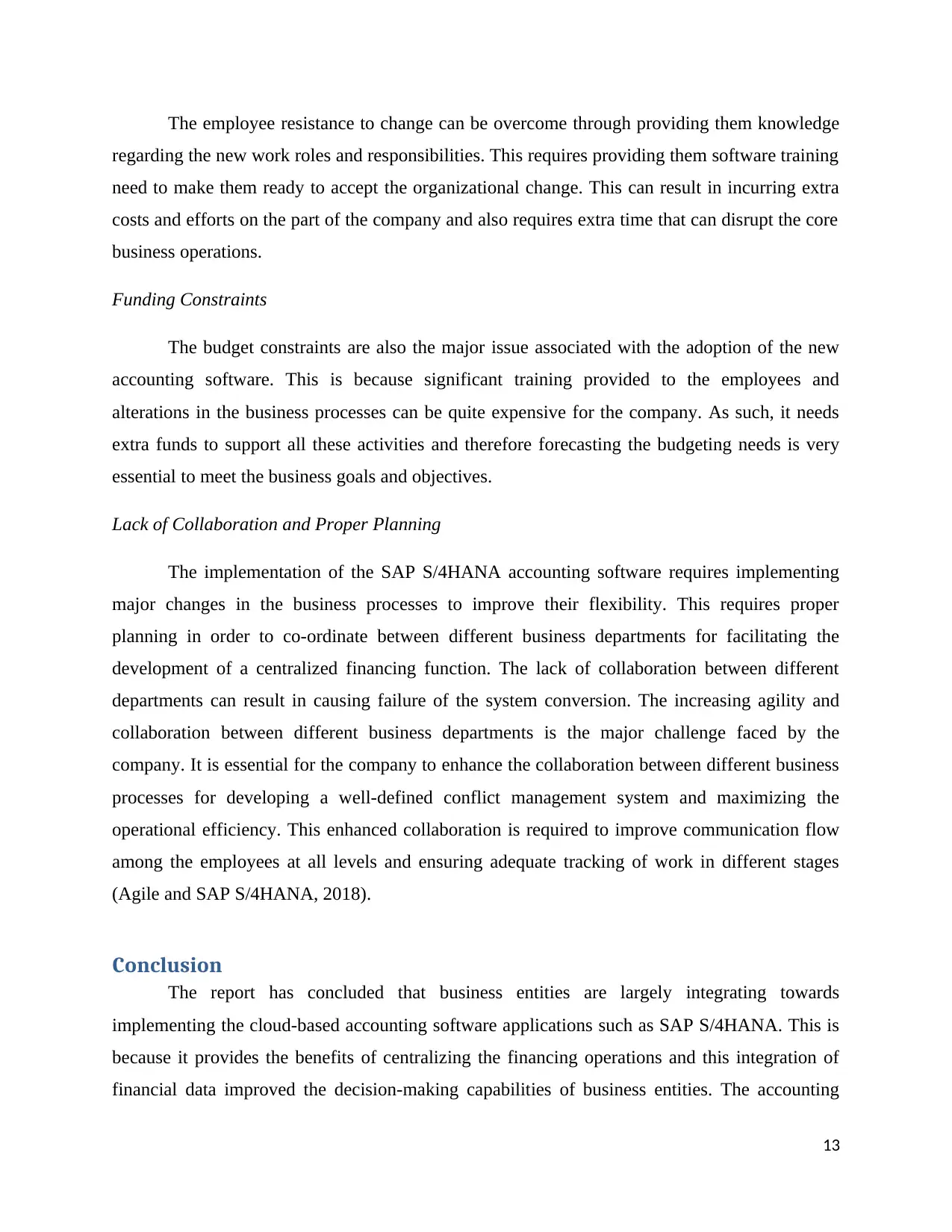
The employee resistance to change can be overcome through providing them knowledge
regarding the new work roles and responsibilities. This requires providing them software training
need to make them ready to accept the organizational change. This can result in incurring extra
costs and efforts on the part of the company and also requires extra time that can disrupt the core
business operations.
Funding Constraints
The budget constraints are also the major issue associated with the adoption of the new
accounting software. This is because significant training provided to the employees and
alterations in the business processes can be quite expensive for the company. As such, it needs
extra funds to support all these activities and therefore forecasting the budgeting needs is very
essential to meet the business goals and objectives.
Lack of Collaboration and Proper Planning
The implementation of the SAP S/4HANA accounting software requires implementing
major changes in the business processes to improve their flexibility. This requires proper
planning in order to co-ordinate between different business departments for facilitating the
development of a centralized financing function. The lack of collaboration between different
departments can result in causing failure of the system conversion. The increasing agility and
collaboration between different business departments is the major challenge faced by the
company. It is essential for the company to enhance the collaboration between different business
processes for developing a well-defined conflict management system and maximizing the
operational efficiency. This enhanced collaboration is required to improve communication flow
among the employees at all levels and ensuring adequate tracking of work in different stages
(Agile and SAP S/4HANA, 2018).
Conclusion
The report has concluded that business entities are largely integrating towards
implementing the cloud-based accounting software applications such as SAP S/4HANA. This is
because it provides the benefits of centralizing the financing operations and this integration of
financial data improved the decision-making capabilities of business entities. The accounting
13
regarding the new work roles and responsibilities. This requires providing them software training
need to make them ready to accept the organizational change. This can result in incurring extra
costs and efforts on the part of the company and also requires extra time that can disrupt the core
business operations.
Funding Constraints
The budget constraints are also the major issue associated with the adoption of the new
accounting software. This is because significant training provided to the employees and
alterations in the business processes can be quite expensive for the company. As such, it needs
extra funds to support all these activities and therefore forecasting the budgeting needs is very
essential to meet the business goals and objectives.
Lack of Collaboration and Proper Planning
The implementation of the SAP S/4HANA accounting software requires implementing
major changes in the business processes to improve their flexibility. This requires proper
planning in order to co-ordinate between different business departments for facilitating the
development of a centralized financing function. The lack of collaboration between different
departments can result in causing failure of the system conversion. The increasing agility and
collaboration between different business departments is the major challenge faced by the
company. It is essential for the company to enhance the collaboration between different business
processes for developing a well-defined conflict management system and maximizing the
operational efficiency. This enhanced collaboration is required to improve communication flow
among the employees at all levels and ensuring adequate tracking of work in different stages
(Agile and SAP S/4HANA, 2018).
Conclusion
The report has concluded that business entities are largely integrating towards
implementing the cloud-based accounting software applications such as SAP S/4HANA. This is
because it provides the benefits of centralizing the financing operations and this integration of
financial data improved the decision-making capabilities of business entities. The accounting
13
Paraphrase This Document
Need a fresh take? Get an instant paraphrase of this document with our AI Paraphraser
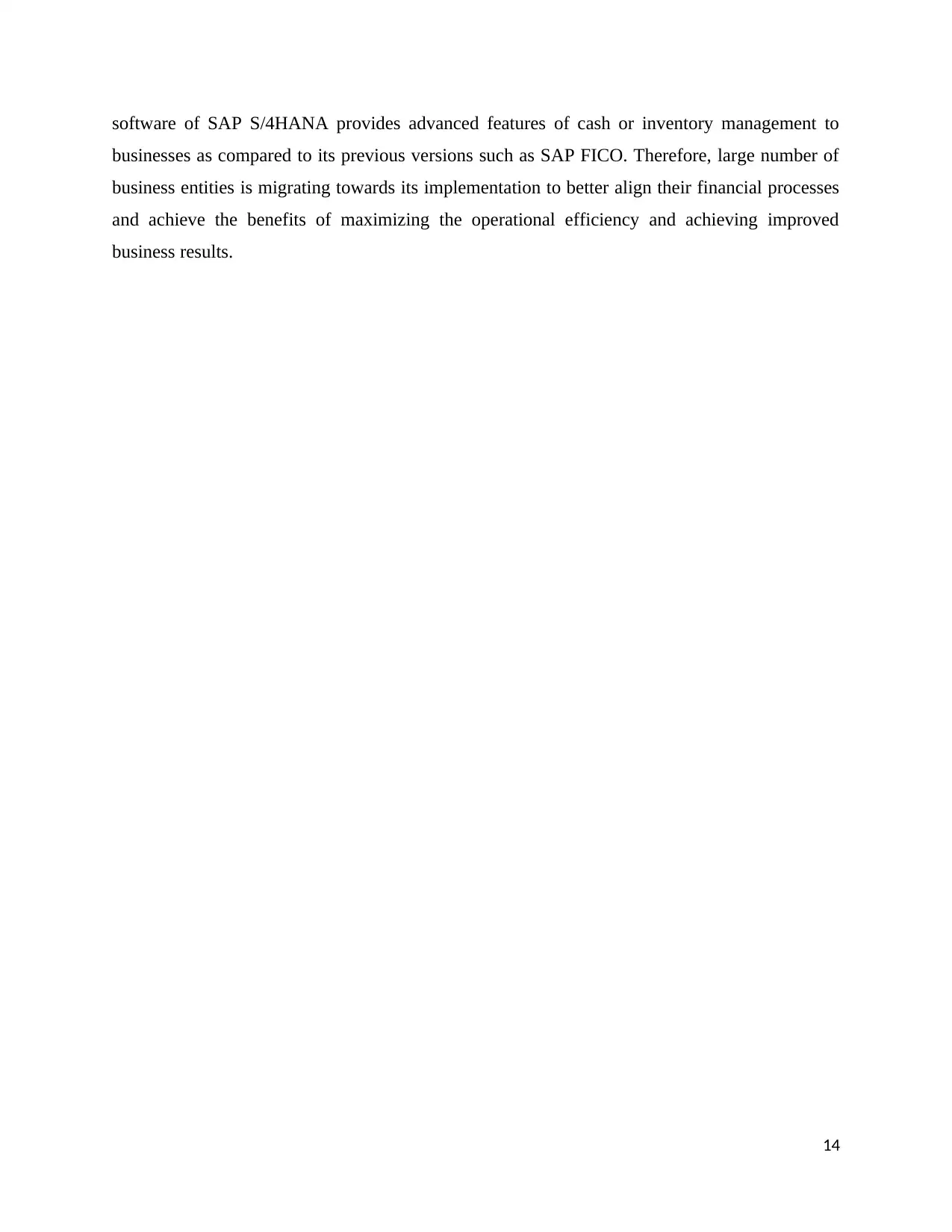
software of SAP S/4HANA provides advanced features of cash or inventory management to
businesses as compared to its previous versions such as SAP FICO. Therefore, large number of
business entities is migrating towards its implementation to better align their financial processes
and achieve the benefits of maximizing the operational efficiency and achieving improved
business results.
14
businesses as compared to its previous versions such as SAP FICO. Therefore, large number of
business entities is migrating towards its implementation to better align their financial processes
and achieve the benefits of maximizing the operational efficiency and achieving improved
business results.
14
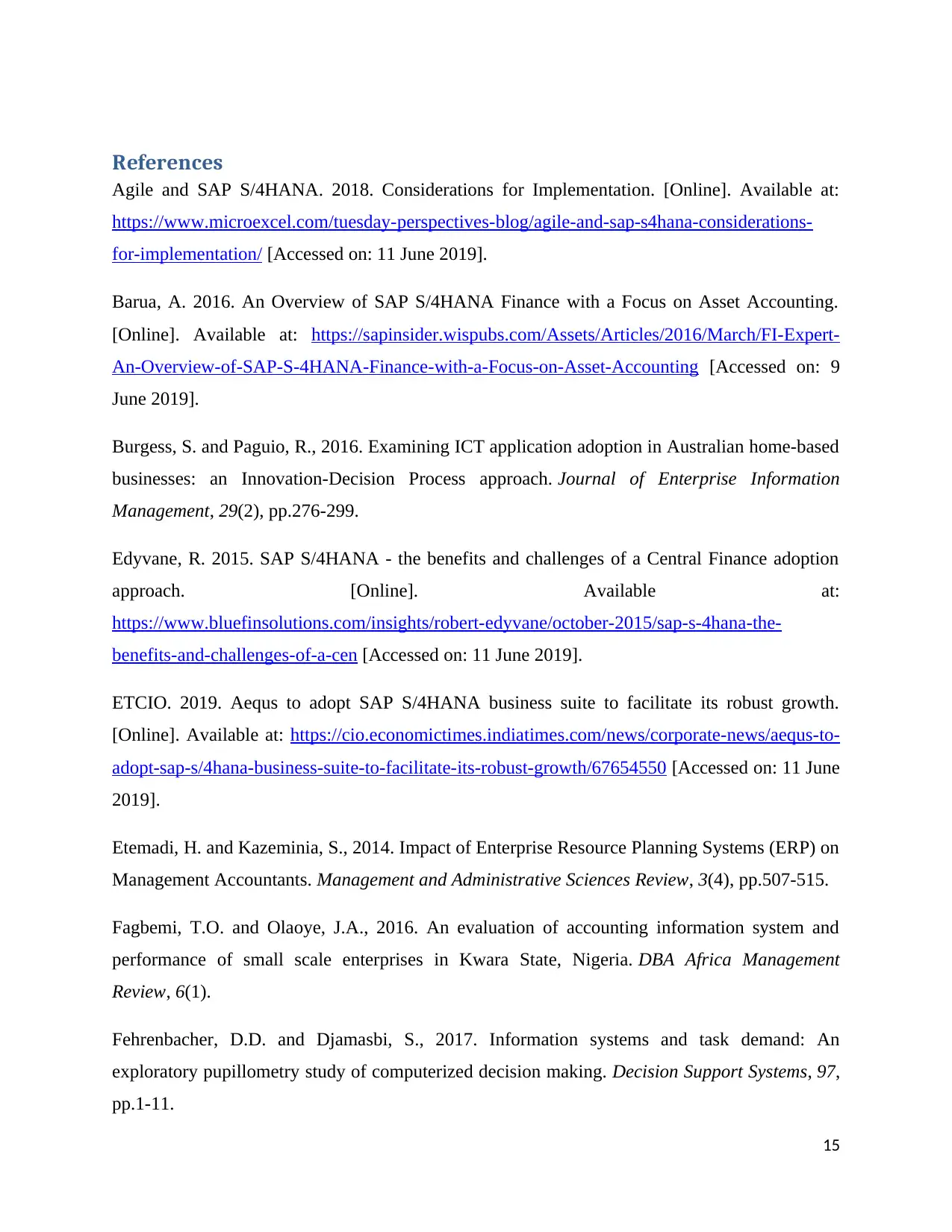
References
Agile and SAP S/4HANA. 2018. Considerations for Implementation. [Online]. Available at:
https://www.microexcel.com/tuesday-perspectives-blog/agile-and-sap-s4hana-considerations-
for-implementation/ [Accessed on: 11 June 2019].
Barua, A. 2016. An Overview of SAP S/4HANA Finance with a Focus on Asset Accounting.
[Online]. Available at: https://sapinsider.wispubs.com/Assets/Articles/2016/March/FI-Expert-
An-Overview-of-SAP-S-4HANA-Finance-with-a-Focus-on-Asset-Accounting [Accessed on: 9
June 2019].
Burgess, S. and Paguio, R., 2016. Examining ICT application adoption in Australian home-based
businesses: an Innovation-Decision Process approach. Journal of Enterprise Information
Management, 29(2), pp.276-299.
Edyvane, R. 2015. SAP S/4HANA - the benefits and challenges of a Central Finance adoption
approach. [Online]. Available at:
https://www.bluefinsolutions.com/insights/robert-edyvane/october-2015/sap-s-4hana-the-
benefits-and-challenges-of-a-cen [Accessed on: 11 June 2019].
ETCIO. 2019. Aequs to adopt SAP S/4HANA business suite to facilitate its robust growth.
[Online]. Available at: https://cio.economictimes.indiatimes.com/news/corporate-news/aequs-to-
adopt-sap-s/4hana-business-suite-to-facilitate-its-robust-growth/67654550 [Accessed on: 11 June
2019].
Etemadi, H. and Kazeminia, S., 2014. Impact of Enterprise Resource Planning Systems (ERP) on
Management Accountants. Management and Administrative Sciences Review, 3(4), pp.507-515.
Fagbemi, T.O. and Olaoye, J.A., 2016. An evaluation of accounting information system and
performance of small scale enterprises in Kwara State, Nigeria. DBA Africa Management
Review, 6(1).
Fehrenbacher, D.D. and Djamasbi, S., 2017. Information systems and task demand: An
exploratory pupillometry study of computerized decision making. Decision Support Systems, 97,
pp.1-11.
15
Agile and SAP S/4HANA. 2018. Considerations for Implementation. [Online]. Available at:
https://www.microexcel.com/tuesday-perspectives-blog/agile-and-sap-s4hana-considerations-
for-implementation/ [Accessed on: 11 June 2019].
Barua, A. 2016. An Overview of SAP S/4HANA Finance with a Focus on Asset Accounting.
[Online]. Available at: https://sapinsider.wispubs.com/Assets/Articles/2016/March/FI-Expert-
An-Overview-of-SAP-S-4HANA-Finance-with-a-Focus-on-Asset-Accounting [Accessed on: 9
June 2019].
Burgess, S. and Paguio, R., 2016. Examining ICT application adoption in Australian home-based
businesses: an Innovation-Decision Process approach. Journal of Enterprise Information
Management, 29(2), pp.276-299.
Edyvane, R. 2015. SAP S/4HANA - the benefits and challenges of a Central Finance adoption
approach. [Online]. Available at:
https://www.bluefinsolutions.com/insights/robert-edyvane/october-2015/sap-s-4hana-the-
benefits-and-challenges-of-a-cen [Accessed on: 11 June 2019].
ETCIO. 2019. Aequs to adopt SAP S/4HANA business suite to facilitate its robust growth.
[Online]. Available at: https://cio.economictimes.indiatimes.com/news/corporate-news/aequs-to-
adopt-sap-s/4hana-business-suite-to-facilitate-its-robust-growth/67654550 [Accessed on: 11 June
2019].
Etemadi, H. and Kazeminia, S., 2014. Impact of Enterprise Resource Planning Systems (ERP) on
Management Accountants. Management and Administrative Sciences Review, 3(4), pp.507-515.
Fagbemi, T.O. and Olaoye, J.A., 2016. An evaluation of accounting information system and
performance of small scale enterprises in Kwara State, Nigeria. DBA Africa Management
Review, 6(1).
Fehrenbacher, D.D. and Djamasbi, S., 2017. Information systems and task demand: An
exploratory pupillometry study of computerized decision making. Decision Support Systems, 97,
pp.1-11.
15
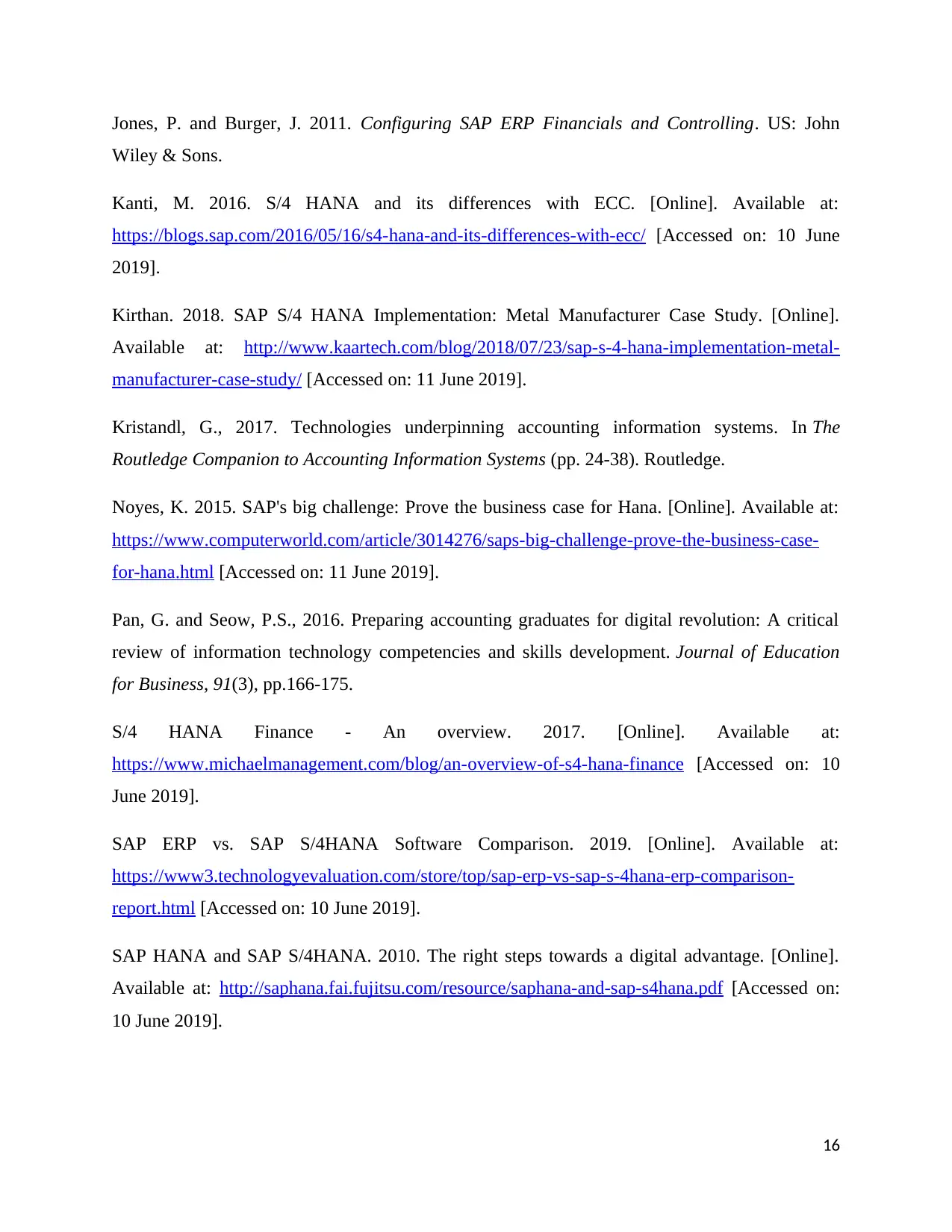
Jones, P. and Burger, J. 2011. Configuring SAP ERP Financials and Controlling. US: John
Wiley & Sons.
Kanti, M. 2016. S/4 HANA and its differences with ECC. [Online]. Available at:
https://blogs.sap.com/2016/05/16/s4-hana-and-its-differences-with-ecc/ [Accessed on: 10 June
2019].
Kirthan. 2018. SAP S/4 HANA Implementation: Metal Manufacturer Case Study. [Online].
Available at: http://www.kaartech.com/blog/2018/07/23/sap-s-4-hana-implementation-metal-
manufacturer-case-study/ [Accessed on: 11 June 2019].
Kristandl, G., 2017. Technologies underpinning accounting information systems. In The
Routledge Companion to Accounting Information Systems (pp. 24-38). Routledge.
Noyes, K. 2015. SAP's big challenge: Prove the business case for Hana. [Online]. Available at:
https://www.computerworld.com/article/3014276/saps-big-challenge-prove-the-business-case-
for-hana.html [Accessed on: 11 June 2019].
Pan, G. and Seow, P.S., 2016. Preparing accounting graduates for digital revolution: A critical
review of information technology competencies and skills development. Journal of Education
for Business, 91(3), pp.166-175.
S/4 HANA Finance - An overview. 2017. [Online]. Available at:
https://www.michaelmanagement.com/blog/an-overview-of-s4-hana-finance [Accessed on: 10
June 2019].
SAP ERP vs. SAP S/4HANA Software Comparison. 2019. [Online]. Available at:
https://www3.technologyevaluation.com/store/top/sap-erp-vs-sap-s-4hana-erp-comparison-
report.html [Accessed on: 10 June 2019].
SAP HANA and SAP S/4HANA. 2010. The right steps towards a digital advantage. [Online].
Available at: http://saphana.fai.fujitsu.com/resource/saphana-and-sap-s4hana.pdf [Accessed on:
10 June 2019].
16
Wiley & Sons.
Kanti, M. 2016. S/4 HANA and its differences with ECC. [Online]. Available at:
https://blogs.sap.com/2016/05/16/s4-hana-and-its-differences-with-ecc/ [Accessed on: 10 June
2019].
Kirthan. 2018. SAP S/4 HANA Implementation: Metal Manufacturer Case Study. [Online].
Available at: http://www.kaartech.com/blog/2018/07/23/sap-s-4-hana-implementation-metal-
manufacturer-case-study/ [Accessed on: 11 June 2019].
Kristandl, G., 2017. Technologies underpinning accounting information systems. In The
Routledge Companion to Accounting Information Systems (pp. 24-38). Routledge.
Noyes, K. 2015. SAP's big challenge: Prove the business case for Hana. [Online]. Available at:
https://www.computerworld.com/article/3014276/saps-big-challenge-prove-the-business-case-
for-hana.html [Accessed on: 11 June 2019].
Pan, G. and Seow, P.S., 2016. Preparing accounting graduates for digital revolution: A critical
review of information technology competencies and skills development. Journal of Education
for Business, 91(3), pp.166-175.
S/4 HANA Finance - An overview. 2017. [Online]. Available at:
https://www.michaelmanagement.com/blog/an-overview-of-s4-hana-finance [Accessed on: 10
June 2019].
SAP ERP vs. SAP S/4HANA Software Comparison. 2019. [Online]. Available at:
https://www3.technologyevaluation.com/store/top/sap-erp-vs-sap-s-4hana-erp-comparison-
report.html [Accessed on: 10 June 2019].
SAP HANA and SAP S/4HANA. 2010. The right steps towards a digital advantage. [Online].
Available at: http://saphana.fai.fujitsu.com/resource/saphana-and-sap-s4hana.pdf [Accessed on:
10 June 2019].
16
Secure Best Marks with AI Grader
Need help grading? Try our AI Grader for instant feedback on your assignments.
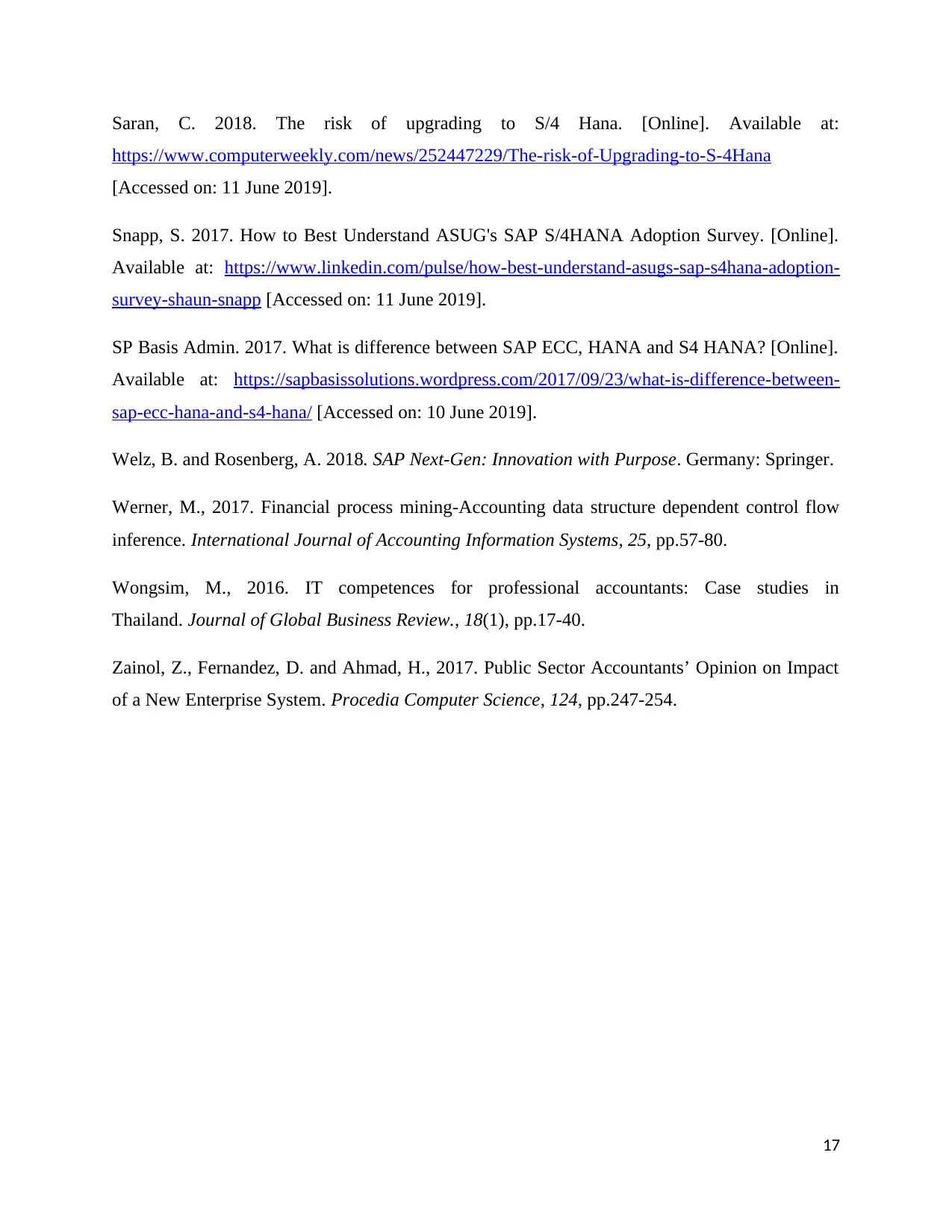
Saran, C. 2018. The risk of upgrading to S/4 Hana. [Online]. Available at:
https://www.computerweekly.com/news/252447229/The-risk-of-Upgrading-to-S-4Hana
[Accessed on: 11 June 2019].
Snapp, S. 2017. How to Best Understand ASUG's SAP S/4HANA Adoption Survey. [Online].
Available at: https://www.linkedin.com/pulse/how-best-understand-asugs-sap-s4hana-adoption-
survey-shaun-snapp [Accessed on: 11 June 2019].
SP Basis Admin. 2017. What is difference between SAP ECC, HANA and S4 HANA? [Online].
Available at: https://sapbasissolutions.wordpress.com/2017/09/23/what-is-difference-between-
sap-ecc-hana-and-s4-hana/ [Accessed on: 10 June 2019].
Welz, B. and Rosenberg, A. 2018. SAP Next-Gen: Innovation with Purpose. Germany: Springer.
Werner, M., 2017. Financial process mining-Accounting data structure dependent control flow
inference. International Journal of Accounting Information Systems, 25, pp.57-80.
Wongsim, M., 2016. IT competences for professional accountants: Case studies in
Thailand. Journal of Global Business Review., 18(1), pp.17-40.
Zainol, Z., Fernandez, D. and Ahmad, H., 2017. Public Sector Accountants’ Opinion on Impact
of a New Enterprise System. Procedia Computer Science, 124, pp.247-254.
17
https://www.computerweekly.com/news/252447229/The-risk-of-Upgrading-to-S-4Hana
[Accessed on: 11 June 2019].
Snapp, S. 2017. How to Best Understand ASUG's SAP S/4HANA Adoption Survey. [Online].
Available at: https://www.linkedin.com/pulse/how-best-understand-asugs-sap-s4hana-adoption-
survey-shaun-snapp [Accessed on: 11 June 2019].
SP Basis Admin. 2017. What is difference between SAP ECC, HANA and S4 HANA? [Online].
Available at: https://sapbasissolutions.wordpress.com/2017/09/23/what-is-difference-between-
sap-ecc-hana-and-s4-hana/ [Accessed on: 10 June 2019].
Welz, B. and Rosenberg, A. 2018. SAP Next-Gen: Innovation with Purpose. Germany: Springer.
Werner, M., 2017. Financial process mining-Accounting data structure dependent control flow
inference. International Journal of Accounting Information Systems, 25, pp.57-80.
Wongsim, M., 2016. IT competences for professional accountants: Case studies in
Thailand. Journal of Global Business Review., 18(1), pp.17-40.
Zainol, Z., Fernandez, D. and Ahmad, H., 2017. Public Sector Accountants’ Opinion on Impact
of a New Enterprise System. Procedia Computer Science, 124, pp.247-254.
17
1 out of 17
Related Documents
Your All-in-One AI-Powered Toolkit for Academic Success.
+13062052269
info@desklib.com
Available 24*7 on WhatsApp / Email
![[object Object]](/_next/static/media/star-bottom.7253800d.svg)
Unlock your academic potential
© 2024 | Zucol Services PVT LTD | All rights reserved.





